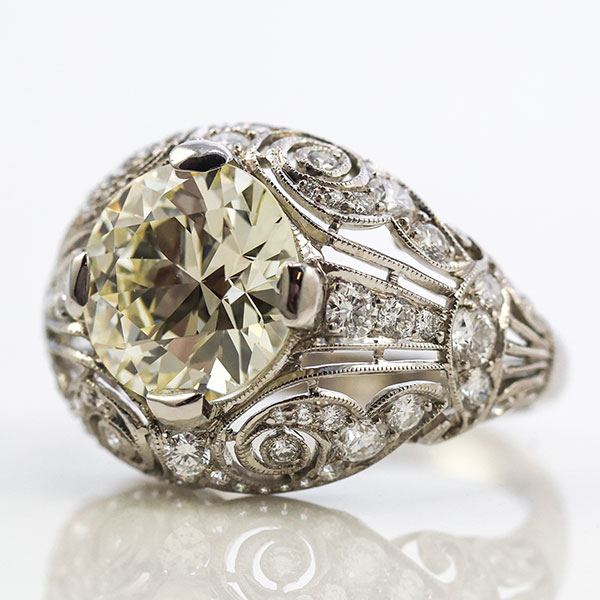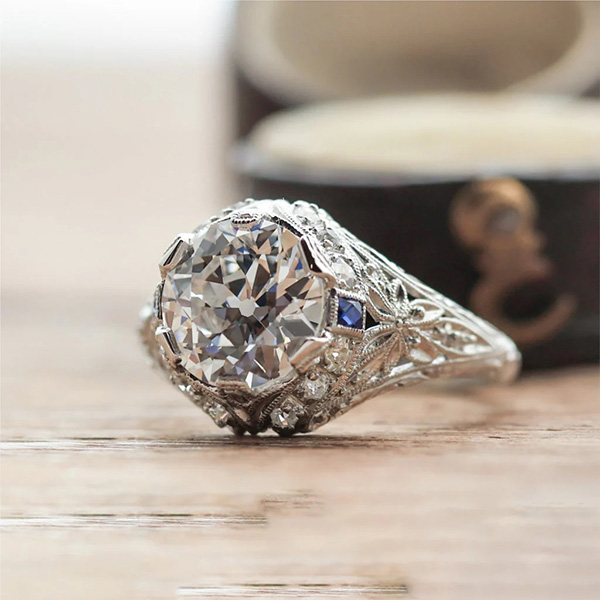
Emma Roberts is my kind of bride-to-be: For her engagement ring, she and fiancé Cody John selected a singular antique old European cut diamond in a spectacularly simple setting.
As a relatively new jewelry writer, I’m fascinated by antique stone cuts, especially on gorgeous larger rings like Roberts’. And I’m not the only one—jewelry pros from companies including the Clear Cut and Greenwich St. Jewelers took to TikTok to examine the actress’ ring and its natural diamond.
Roberts has 20.6 million followers on Instagram, so lots of people got to see her ring and examine its awesome diamond, which is estimated at 4 to 6 carats, depending on who you ask.
To learn more about this stone, I asked Joseph Denaburg of Levy’s Fine Jewelry in Birmingham, Ala., about antique diamond cuts and why they’re trending. The first thing the young jeweler said? He doesn’t believe in trends—people, including Roberts, are just choosing gemstones and jewelry that suit them best.
“The only real trend that exists at the moment is individualism,” says Denaburg, the marketing director and digital strategist at Levy’s.

When Denaburg joined his family’s jewelry company in December 2013, one of his first tasks was to create a new website for the business and write all of the gemstone and history content for it. He, too, became fascinated by vintage jewelry and antique cuts, taking classes at the GIA and working toward his certification as a Graduate Gemologist.
These days Denaburg is responsible for Levy’s social media, and his top advice for jewelers is to post more videos—they keep prospective clients’ eyes on your platform longer, and you’ll get more viewers and engagement as a reward. He’s done many social media posts about old European cuts, which he says deserve the attention they’re now getting.
Antique cuts can be hard to find, he notes—in particular, larger stones like the one Roberts snagged. “The reason that these stones are so rare is because from the 1950s into the 1980s, nobody wanted them. The industry was coming up with all of these new brilliant cuts, and people didn’t see the value in what was considered old, ugly, weirdly shaped stones,” Denaburg says. 
Joseph Denaburg says these are drawings of European cuts surrounding the artwork from an advertisement for a diamond-cutting firm, from the personal scrapbook of Henry D. Morse, a famous stone cutter.
“Diamond dealers bought them up, especially the whitest ones, and recut them into modern brilliants,” he explains. “A lot of European cuts were probably old mine cuts that got a chip in the corner, so they rounded them out.”
I was hoping to find a pair of old mine or old Euro earrings (or perhaps a pendant), but Denaburg says those are typically rarer than, let’s say, a brooch or a ring. Earrings require two identical stones, and wearing earrings didn’t use to be as common as it is today. I’ll continue my hunt— because, like Roberts, I value the rarity of the cut as well as how it stands out in today’s modern world.
Denaburg spent more than three years creating the diamond-cutting history on the Levy’s website, and he hopes current and potential clients read it, discover something new to love (as Roberts likely did with her stone), and buy more jewelry.
“I wanted it to be the most complete and interesting history of diamond cutting that exists online for consumers,” he says. “These stones have so much character to them, and there’s something special about looking at a stone and realizing it was cut 100 or 200 years ago. You can transport yourself back in a time through a piece of jewelry.”
Top: This 3.53 ct. European cut diamond ($33,750) is an example of the antique cuts available from Levy’s Fine Jewelry that brides such as newly engaged actress Emma Roberts are seeking. (Photos courtesy of Levy’s Fine Jewelry)
- Subscribe to the JCK News Daily
- Subscribe to the JCK Special Report
- Follow JCK on Instagram: @jckmagazine
- Follow JCK on X: @jckmagazine
- Follow JCK on Facebook: @jckmagazine






